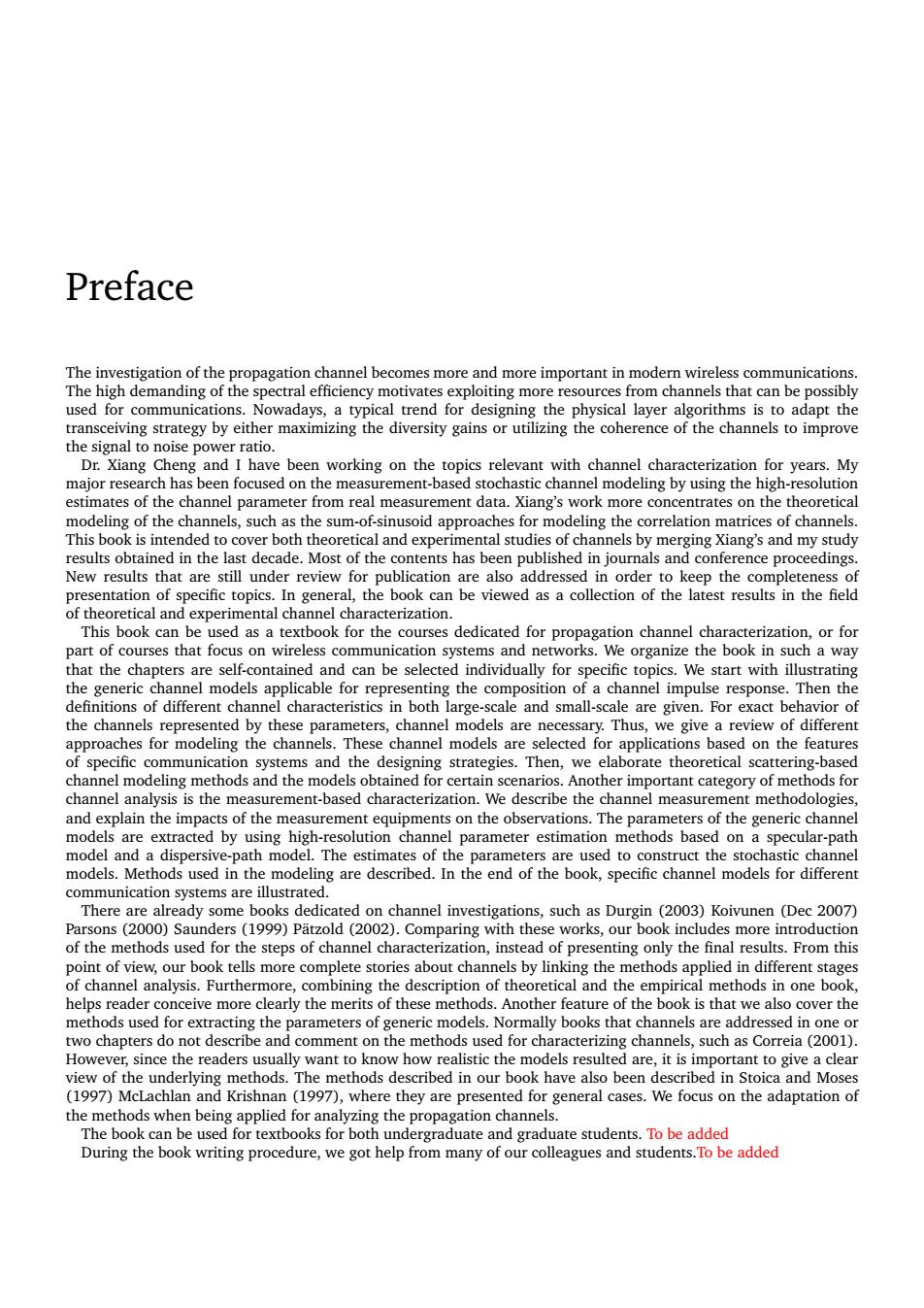正在加载图片...

Preface mprove 二 usoid approaches for mod ling the of channel tion of def generic chcaor representing the compos tion o a channel impulse respons Then the models are review of differe applica the dene Then,dborate th ese channel models are selected fo ns bas on the features ant of methods for headon e deombe the chame a dispersive- ruct the s channe used in eling are de sfor different Companng thth poin of book complete stories about channels by linking the methods applied in different stage of channe analysis.Furtherm ore,combining and t ssed in one o wo chapters do not describe ar used for cha s,such as and Mose 1997) (1997),where they are presem d for general We focus on the adaptationo During the book writing procedure,we got help from many of our colleagues and students.To be added Preface The investigation of the propagation channel becomes more and more important in modern wireless communications. The high demanding of the spectral efficiency motivates exploiting more resources from channels that can be possibly used for communications. Nowadays, a typical trend for designing the physical layer algorithms is to adapt the transceiving strategy by either maximizing the diversity gains or utilizing the coherence of the channels to improve the signal to noise power ratio. Dr. Xiang Cheng and I have been working on the topics relevant with channel characterization for years. My major research has been focused on the measurement-based stochastic channel modeling by using the high-resolution estimates of the channel parameter from real measurement data. Xiang’s work more concentrates on the theoretical modeling of the channels, such as the sum-of-sinusoid approaches for modeling the correlation matrices of channels. This book is intended to cover both theoretical and experimental studies of channels by merging Xiang’s and my study results obtained in the last decade. Most of the contents has been published in journals and conference proceedings. New results that are still under review for publication are also addressed in order to keep the completeness of presentation of specific topics. In general, the book can be viewed as a collection of the latest results in the field of theoretical and experimental channel characterization. This book can be used as a textbook for the courses dedicated for propagation channel characterization, or for part of courses that focus on wireless communication systems and networks. We organize the book in such a way that the chapters are self-contained and can be selected individually for specific topics. We start with illustrating the generic channel models applicable for representing the composition of a channel impulse response. Then the definitions of different channel characteristics in both large-scale and small-scale are given. For exact behavior of the channels represented by these parameters, channel models are necessary. Thus, we give a review of different approaches for modeling the channels. These channel models are selected for applications based on the features of specific communication systems and the designing strategies. Then, we elaborate theoretical scattering-based channel modeling methods and the models obtained for certain scenarios. Another important category of methods for channel analysis is the measurement-based characterization. We describe the channel measurement methodologies, and explain the impacts of the measurement equipments on the observations. The parameters of the generic channel models are extracted by using high-resolution channel parameter estimation methods based on a specular-path model and a dispersive-path model. The estimates of the parameters are used to construct the stochastic channel models. Methods used in the modeling are described. In the end of the book, specific channel models for different communication systems are illustrated. There are already some books dedicated on channel investigations, such as Durgin (2003) Koivunen (Dec 2007) Parsons (2000) Saunders (1999) Pätzold (2002). Comparing with these works, our book includes more introduction of the methods used for the steps of channel characterization, instead of presenting only the final results. From this point of view, our book tells more complete stories about channels by linking the methods applied in different stages of channel analysis. Furthermore, combining the description of theoretical and the empirical methods in one book, helps reader conceive more clearly the merits of these methods. Another feature of the book is that we also cover the methods used for extracting the parameters of generic models. Normally books that channels are addressed in one or two chapters do not describe and comment on the methods used for characterizing channels, such as Correia (2001). However, since the readers usually want to know how realistic the models resulted are, it is important to give a clear view of the underlying methods. The methods described in our book have also been described in Stoica and Moses (1997) McLachlan and Krishnan (1997), where they are presented for general cases. We focus on the adaptation of the methods when being applied for analyzing the propagation channels. The book can be used for textbooks for both undergraduate and graduate students. To be added During the book writing procedure, we got help from many of our colleagues and students.To be added